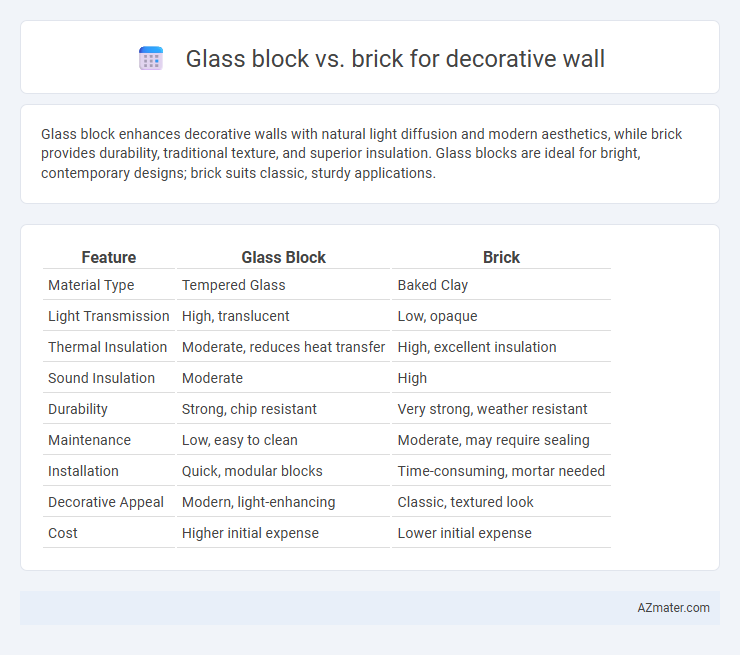Glass block enhances decorative walls with natural light diffusion and modern aesthetics, while brick provides durability, traditional texture, and superior insulation. Glass blocks are ideal for bright, contemporary designs; brick suits classic, sturdy applications.
Table of Comparison
| Feature | Glass Block | Brick |
|---|---|---|
| Material Type | Tempered Glass | Baked Clay |
| Light Transmission | High, translucent | Low, opaque |
| Thermal Insulation | Moderate, reduces heat transfer | High, excellent insulation |
| Sound Insulation | Moderate | High |
| Durability | Strong, chip resistant | Very strong, weather resistant |
| Maintenance | Low, easy to clean | Moderate, may require sealing |
| Installation | Quick, modular blocks | Time-consuming, mortar needed |
| Decorative Appeal | Modern, light-enhancing | Classic, textured look |
| Cost | Higher initial expense | Lower initial expense |
Introduction to Glass Block and Brick Decorative Walls
Glass block decorative walls offer a combination of translucency and durability, allowing natural light to pass through while maintaining privacy and structural integrity. Brick decorative walls provide a classic, textured aesthetic with exceptional strength and versatility in both interior and exterior applications. Both materials serve distinct architectural purposes, enhancing visual appeal and functionality in various design projects.
Aesthetic Appeal: Glass Block vs Brick
Glass blocks offer a modern, translucent aesthetic that enhances natural light diffusion and creates a sleek, contemporary look, ideal for brightening interior spaces and adding visual interest. Bricks provide a classic, textured appearance with warm, earthy tones that evoke a timeless, rustic charm, making them suitable for traditional or industrial design themes. The choice between glass block and brick ultimately depends on the desired light permeability and style impact, with glass emphasizing luminosity and brick prioritizing solidity and texture.
Light Transmission and Privacy Factors
Glass blocks provide superior light transmission, allowing natural light to penetrate while maintaining privacy due to their translucent texture. Brick walls offer excellent privacy and security but significantly reduce light flow into interior spaces. Choosing between glass blocks and bricks depends on the balance needed between ambient lighting and privacy levels in decorative wall design.
Insulation and Energy Efficiency Comparison
Glass blocks offer superior natural light transmission while providing moderate thermal insulation, making them energy-efficient for decorative walls in well-lit spaces. Bricks provide higher thermal mass and better sound insulation, helping regulate indoor temperatures by retaining heat in winter and keeping interiors cool during summer. Choosing between glass blocks and bricks depends on balancing light diffusion needs with desired insulation and energy efficiency levels in the specific building environment.
Durability and Maintenance Requirements
Glass blocks offer exceptional durability with resistance to moisture, corrosion, and weathering, making them ideal for decorative walls in humid or exterior environments. They require minimal maintenance, as their smooth surfaces resist dirt buildup and can be easily cleaned with standard glass cleaners. In contrast, brick walls provide robust structural integrity but may demand periodic sealing and mortar repairs to prevent water damage and maintain appearance over time.
Installation Process and Complexity
Glass blocks require precise alignment and specialized mortar or silicone for installation, often demanding skilled labor to achieve a seamless, watertight finish. Brick installation involves laying individual units with mortar, a process that is more familiar to most masons but time-consuming due to the weight and curing time. The complexity of glass block walls increases with custom shapes and embedded lighting, while brick walls are more adaptable to various structural requirements but lack the translucent properties of glass blocks.
Cost Considerations: Glass Block vs Brick
Glass blocks typically cost more per square foot than traditional bricks due to manufacturing and installation complexity. Brick offers lower material and labor costs, making it more economical for large-scale decorative walls. Maintenance expenses for glass blocks can also be higher, as specialized cleaning and repairs are often required compared to durable and low-maintenance brick surfaces.
Versatility in Design and Applications
Glass blocks offer exceptional versatility in design and applications with their ability to transmit light while maintaining privacy, making them ideal for decorative walls in bathrooms, kitchens, and facades. Their translucent nature and variety of shapes, sizes, and textures provide creative freedom to craft dynamic patterns and visual effects. Bricks deliver robust structural support and a timeless aesthetic, suitable for rustic or industrial-style decorative walls, but they lack the light-enhancing qualities and design flexibility of glass blocks.
Safety and Security Aspects
Glass blocks enhance safety by offering shatter-resistant properties that prevent easy break-ins, while still allowing natural light to filter through. Bricks provide robust physical security with high impact resistance and durability against forced entry. For optimal security, glass blocks often incorporate reinforced or laminated designs, whereas bricks rely on their dense, solid structure to deter intrusions.
Environmental Impact and Sustainability
Glass blocks offer superior sustainability due to their recyclability and energy-efficient thermal properties, reducing heating and cooling demands in buildings. Bricks, often made from clay or concrete, have a higher carbon footprint from manufacturing and resource extraction but provide durability and thermal mass that can improve energy efficiency over time. Choosing glass blocks supports reduced waste and lower embodied energy, while bricks excel in long-term structural sustainability and local material availability.

Infographic: Glass block vs Brick for Decorative wall
 azmater.com
azmater.com